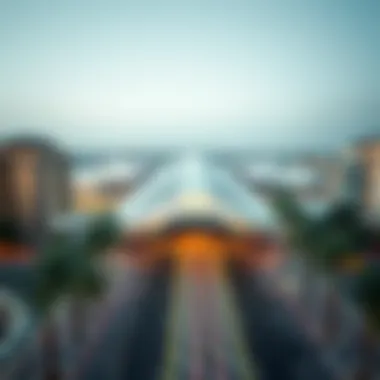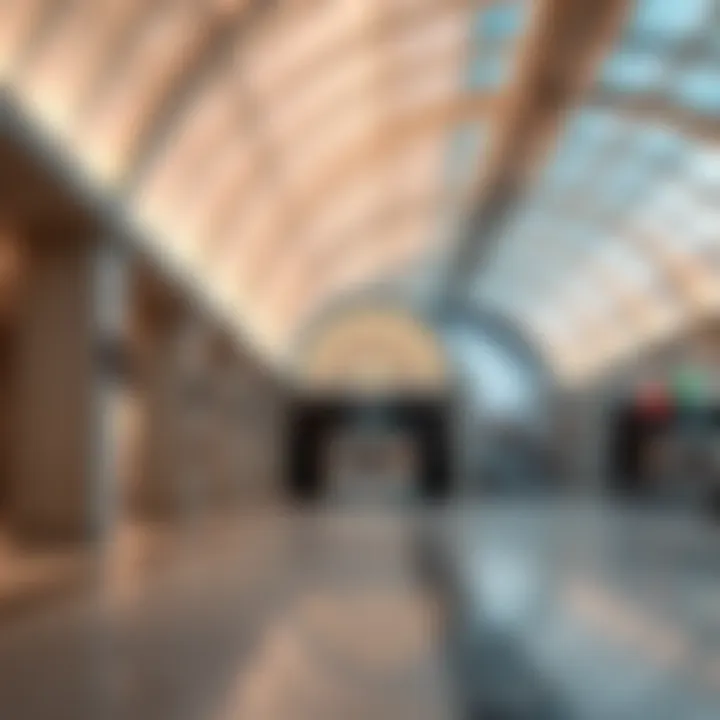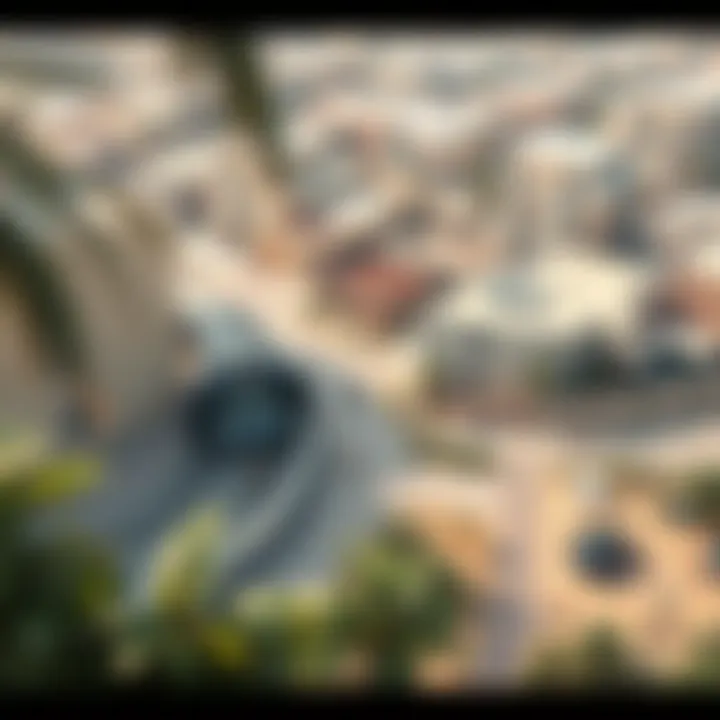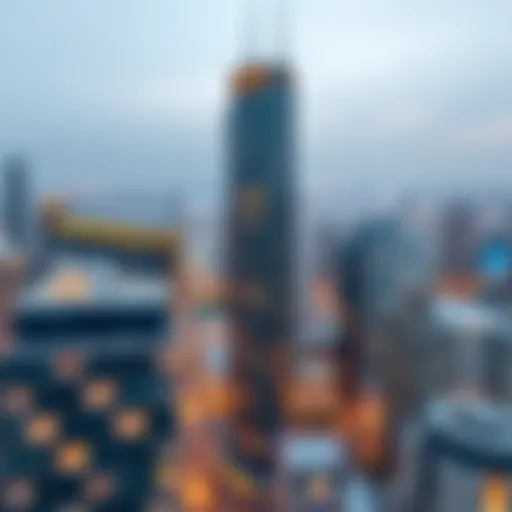Al Jafiliya Metro: Transforming Dubai's Urban Connectivity


Intro
The Al Jafiliya Metro station is not just a stop on a line; it’s a reflection of Dubai’s forward momentum in urban transit. As the city continuously reinvents itself, the metro plays an indispensable role in bridging the various neighborhoods and enhancing accessibility. Understanding this station's significance is essential, especially for investors, property managers, and residents who seek to navigate the ever-evolving landscape of Dubai’s connectivity and real estate.
For many, the allure of Dubai lies not only in its iconic skyline but also in its intricate web of transport systems that connect every corner of this bustling metropolis. With the advent of the Al Jafiliya station, there's a shift that parallels the city's own growth. It's more than just concrete and steel; it’s a hub that signifies opportunity and potential.
In this exploration, we will dissect the various elements that contribute to the Al Jafiliya Metro's impact—from its architectural finesse to its role in shaping real estate trends.
As the city thrives, so does the importance of understanding how these metro innovations affect urban dynamics. Join us as we embark on this comprehensive analysis.
Historical Context of the Al Jafiliya Metro
The Al Jafiliya Metro station stands as a pivotal element in the narrative of Dubai's urban evolution. Its establishment and operational significance mark a turning point in enhancing connectivity within a city that is already recognized for its rapid growth and sophistication. In understanding the historical context of the Al Jafiliya Metro, one can discern how public transport infrastructure not only facilitates movement but also reflects broader socio-economic trends and urban planning strategies.
Development Timeline
Dubai's ambition to establish a metro system began in the early 2000s, a period characterized by a feverish pace of development and investment in infrastructure. Construction of the metro network, which encompasses various lines, kicked off in 2006, with Al Jafiliya station opening its doors to the public in 2011. This timeline illustrates a journey fueled not just by necessity but also by a vision of modernity, with the metro's design and function embodying a responsive approach to the transportation needs of a growing population.
During its development, several key challenges were encountered, including the integration of advanced technologies and ensuring safety standards. However, these were overcome through strategic investments and collaborations with experienced contractors, leading to the successful establishment of one of Dubai's main metro stations.
Key Milestones in Metro Expansion
The Al Jafiliya station serves as a testament to several milestones in Dubai's metro expansion. From its inception, the project has had profound implications on urban connectivity. Here's a closer look at a few important milestones:
- Completion of the Red Line: The completion of the Red Line in 2010 heralded the maiden metro service in Dubai. Al Jafiliya emerged as a vital hub, integrating seamlessly with existing transit points.
- Inauguration of the Green Line: The launch of the Green Line in 2011 complemented the Red Line, enhancing access further across the city and enriching the transit experience for residents and visitors alike.
- Adoption of Smart Technologies: As part of the metro's evolution, the incorporation of smart technologies and automated systems has positioned Al Jafiliya station at the forefront of urban transit solutions, ensuring efficient operations and real-time service updates.
As the metro network continues to grow, with plans for future expansions and upgrades, the historical context of the Al Jafiliya station highlights its role not only in addressing immediate transport needs but also in shaping the urban landscape for years to come. This perspective can serve as a foundation for understanding subsequent sections of this article, wherein the architectural features, community impact, and future development surrounding the Al Jafiliya Metro will be explored, providing a rounded picture of its significance in Dubai’s journey toward becoming a global city.
“Public transport connectivity is a cornerstone of urban development, significantly influencing real estate trends and social dynamics.”
Architectural Features of Al Jafiliya Metro Station
The architectural features of the Al Jafiliya Metro Station play a critical role in defining its identity, not just as a transit hub but as a landmark within Dubai’s urban fabric. This station is a reflection of modern design sensibilities blended with cultural nuances that resonate with both residents and visitors. The design is not only aesthetic but also practical, prioritizing functionality and user experience, making it an essential part of the public transportation ecosystem.
Design Philosophy
Al Jafiliya Metro Station is characterized by a design philosophy that emphasizes openness and accessibility. The flowing lines and spacious interiors create a sense of movement that aligns with the dynamic rhythm of the city. Noteworthy is the use of natural light; large windows and skylights allow sunlight to flood the station during the day, offering a warm and inviting atmosphere. The design promotes an intuitive flow of foot traffic, guiding passengers seamlessly from entrances to platforms.
The architectural style also resonates with Dubai's cultural heritage. For instance, certain design elements echo traditional Islamic patterns, subtly woven into the station's glass and metal façades. This element pays homage to the city’s rich history while celebrating its rapid modernization. The station stands not just as a means of transport but also as a visual narrative of Dubai's journey from its roots to its futuristic aspirations.
Materials and Sustainability
Material selection for Al Jafiliya Metro Station was approached with sustainability in mind, a vital factor in contemporary architecture. A blend of environmentally friendly materials has been chosen, showcasing the commitment to reducing carbon footprints. For instance, the extensive use of recycled metals and sustainable concrete not only lowers environmental impact but also enhances durability.
In terms of energy efficiency, the station incorporates advanced technology such as solar panels and energy-efficient lighting systems. These initiatives not only cut operational costs but also contribute to Dubai's ambitious sustainability goals. Additionally, the landscaping around the station uses native plant species, requiring less water and maintenance while promoting local biodiversity.
"The Al Jafiliya Metro Station is a pioneering example of modern transport infrastructure that harmonizes design with ecological responsibility."
For more on Dubai’s urban development, visit Dubai Government or Visit Dubai to explore how public infrastructure shapes city growth.
Connecting Communities: The Role of Al Jafiliya Metro
The Al Jafiliya Metro station is not just a stop on Dubai’s ever-expanding transit map; it’s a vital link in the city’s vast web of connectivity. This station, serving thousands of commuters daily, plays a key role in knitting together various neighborhoods and enhancing the quality of life for residents. Its importance is felt far beyond just transportation; it facilitates social interactions, economic opportunities, and overall community cohesion.


Integration with Other Transport Modes
One of the standout features of the Al Jafiliya Metro is its seamless integration with other transport systems. The station is strategically located close to major bus routes and taxi stands, making it a hub for various transit options. For individuals relying on public transport, this connectivity is not only convenient but essential for smooth, hassle-free travel.
- Buses: Numerous bus lines converge at Al Jafiliya Metro, offering residents access to different areas of the city. This intermodal connection means that a person can easily transition from the metro to a bus without the need for extensive walking or waiting times.
- Taxis and Ride-Sharing: Facilities for taxis and rideshares are readily available, allowing for flexibility in travel plans. Whether one is in a rush for a meeting or just needs a quick lift home, options are close at hand.
- Future Developments: With upcoming projects slated for nearby areas, the connection between these transport modes is expected to strengthen further, effectively broadening choices for commuters.
The potential for Al Jafiliya to serve as a multi-modal transit hub positions it as a cornerstone for daily commuting, easing the pressure on road traffic while promoting a greener approach to transportation.
Impact on Local Neighborhoods
The advent of the Al Jafiliya Metro station has notable implications for the surrounding neighborhoods. Not only does it improve commutability, but it also influences both residential living and commercial activity in ways that resonate throughout the community.
- Neighborhood Dynamics: With excellent transport links, local neighborhoods see an increase in foot traffic, contributing to a vibrant atmosphere. Shops, cafes, and services flourish, as the flow of visitors supports local businesses. Residents benefit from having amenities within easy reach, enhancing day-to-day living.
- Property Values: Proximity to the metro station has a significant impact on real estate trends. Properties within walking distance of Al Jafiliya have seen a boost in value, as potential buyers recognize the advantage of easy access to public transport. More investors are looking into properties in the area, anticipating future appreciation in value.
- Community Engagement: The station is a focal point for local events and gatherings. By facilitating access to diverse activities, it helps create a sense of community that fosters engagement among residents. Events can range from cultural festivals to pop-up markets, all promoting local talent and offering platforms for creativity.
Economic Implications of the Al Jafiliya Metro
The Al Jafiliya Metro station stands as a pivotal element in Dubai’s urban landscape, not only enhancing connectivity but also reshaping the economic fabric of the surrounding areas. As investors and property developers tune into the city's pulse, understanding the financial implications of this metro station becomes crucial. The discussion revolves around property value trends and the burgeoning business opportunities that inevitably spring up in its vicinity.
Property Value Trends
The introduction of the Al Jafiliya Metro has sparked a notable change in property values in the surrounding neighborhoods. Properties within walking distance of the station are witnessing upward trends in value, a phenomenon often seen in urban developments integrated with robust public transit. This increase is driven by several factors:
- Accessibility: The ease of commuting attracts potential homeowners and renters, enhancing demand for both residential and commercial properties.
- Desirability: Proximity to a metro station imbues an area with an urban charm, making it more appealing to younger professionals and families alike.
- Long-Term Investments: Investors are keen to capitalize on the projected increase in property values, leading to a surge in development projects that cater to a growing list of amenities that residents seek.
Statistics highlight that throughout 2022, areas close to Al Jafiliya reported a property value increase of approximately 15% when compared to previous years. This trend is anticipated to continue as more developments unfold.
Business Development in Proximity
With the Al Jafiliya Metro station acting as a conduit for traffic, businesses are flocking to its vicinity eager to establish a foothold. This burgeoning economic activity manifests in various ways:
- Retail Spaces: Local shops and high-end retail outlets have begun to emerge, leveraging the foot traffic brought in by metro commuters. For instance, a well-known coffee shop chain opened two locations nearby, anticipating high customer turnover.
- Dining Options: Restaurants and cafes are popping up to cater to not just commuters but also locals drawn by the convenience.
- Service Industries: The metro's presence encourages the growth of service-oriented businesses such as dry cleaners, fitness centers, and real estate agencies that aim to serve the needs of new residents.
Navigating Al Jafiliya: Accessibility and User Experience
The Al Jafiliya Metro station stands as a testament to how public transportation can dramatically reshape the accessibility of a metropolitan area. Understanding the station’s design and the experience it offers to users is paramount for investors, property managers, and residents alike. Accessibility is not just about reaching a destination; it encompasses a seamless journey that caters to a wide array of passenger needs.
Notably, several elements define the accessibility and user experience at Al Jafiliya. One significant aspect is the integration of various transport modes. The station creates an interface to connect with buses and taxis, reducing distances travelers may need to traverse on foot. This interconnectedness facilitates a fluid movement across Dubai, which is particularly beneficial for business professionals and tourists exploring the city.
Passenger Facilities and Amenities
Passengers utilizing the Al Jafiliya Metro can expect a myriad of amenities designed for comfort and efficiency. The station's layout is intuitively organized, with clear signage in multiple languages, ensuring everyone can navigate with ease. Furthermore, escalators and elevators are plentiful, allowing for smooth transitions between different levels, a crucial factor for those with mobility challenges.
To enhance the overall experience, the waiting areas are spacious and well-furnished. Travelers can find charging stations for their electronic devices, which mitigates the common inconvenience of a drained phone battery during commutes. Additionally, clean and accessible restroom facilities are available, making long waits more bearable. There are also designated spaces for families, such as family-friendly areas and stroller parking, acknowledging young passengers' unique needs.
In terms of convenience, retail outlets and food stalls provide easy access to refreshments and travel essentials. This attention to passenger needs underscores Al Jafiliya Metro's commitment to enhancing the commuter experience.
Safety and Security Measures
Safety is a considerable concern in any urban transit system, and Al Jafiliya Metro does not fall short in its protective protocols. The station is equipped with advanced CCTV surveillance, offering real-time monitoring that contributes to passenger safety throughout the premises. Security personnel are visibly present, ensuring swift assistance should any issues arise.
Moreover, the design includes multiple emergency exits and clear evacuation routes. Regular safety drills prepare staff to respond effectively in emergencies, reinforcing the station’s commitment to a secure environment.
Another feature worth mentioning is the well-maintained lighting that illuminates the passageways, ensuring passengers feel safe at all hours. Furthermore, accessibility features for emergency services, like easy access routes for first responders, have been integrated into the infrastructure.
"Safety and user experience go hand in hand; the better the latter, the more secure people feel using the service."


By taking a holistic approach that intertwines safety with user experience, Al Jafiliya Metro not only serves as a transportation hub but also enriches the urban fabric of Dubai. It is clear that thoughtful design choices and a proactive approach to accessibility make navigating through Al Jafiliya a modern-day ease.
Future Development around Al Jafiliya Metro
The future development surrounding Al Jafiliya Metro station is pivotal for understanding the shifting landscape of Dubai. As the metro line has evolved, so have the opportunities that sprout around it. This crucial junction serves not just as a transit point but as a catalyst for broader urban improvement. The plans in motion promise to bridge gaps in mobility, enhance residential appeal, and bolster economic viability in adjacent neighborhoods.
Upcoming Projects in the Vicinity
With the governmental ambitions to expand Dubai's infrastructure, several projects are on the horizon that show significant promise. Initiatives include:
- New Residential Complexes: Developers are eyeing prime plots near Al Jafiliya for high-rise apartments aimed at both expats and local families. This trend caters well to the increasing demand for housing in a city known for its diverse population.
- Commercial Spaces: Plans for shopping complexes and office buildings are in the works, enhancing the area’s economic landscape. By providing space for small and medium enterprises, the metro station will not only drive foot traffic but also boost local entrepreneurship.
- Public Amenities: Following a blueprint focused on livability, green parks and recreational facilities are being designed to create vibrant public spaces. Such developments aim to attract families, blending urban living with nature.
These projects distinctly lean into the advantages of the metro’s connectivity. For instance, easy access to transportation will dramatically influence buyer enthusiasm for properties, increasing the value of investments in the vicinity.
Long-Term Urban Planning Strategies
Beyond the immediate projects, long-term urban planning strategies are crucial for realizing a sustainably integrated community. The following elements illustrate this vision:
- Smart City Initiatives: Al Jafiliya's development aligns with Dubai’s Smart City strategy, implementing technology-driven solutions such as intelligent traffic systems, energy-efficient buildings, and integrated public transport. This modern approach ensures residents enjoy a seamless lifestyle.
- Mixed-Use Developments: Emphasizing multifunctional spaces blends residential, commercial, and recreational areas, thereby fostering urban density without compromising quality of life. This can reduce commuting times and support a more cohesive living environment.
- Sustainability Goals: With a focus on green development, projects surrounding Al Jafiliya include eco-friendly designs, energy conservation measures, and waste management improvements. Future developments aim to minimize environmental impact while enhancing urban aesthetics.
Investors and developers should pay close attention to these long-term strategies. As urbanization accelerates, understanding the intricacies of development plans becomes essential for making informed decisions in a competitive market.
"Investing in metro-adjacent areas isn't just about real estate; it's about becoming part of a thriving community due for growth and transformation."
By prioritizing these aspects, the Al Jafiliya Metro area is well-positioned to become a beacon of innovation and urban synergy, creating lasting benefits for residents and stakeholders alike.
Cultural Significance of the Al Jafiliya Metro
The Al Jafiliya Metro station has emerged as a focal point within the cultural and social fabric of Dubai. It is not merely a transportation hub but a space where community meets art, identity, and progressive urbanization. The metro serves as a powerful symbol of Dubai's rapid development while fostering local culture, making it crucial for understanding the dynamics of the city.
Art Installations and Public Spaces
Art is often viewed as the heartbeat of a community, and Al Jafiliya Metro station is a testament to that idea. From stunning murals depicting the history of Dubai to interactive art pieces that encourage public engagement, the station becomes an exhibition space of sorts.
- Local Artists: Many installations are curated from local talents, featuring their interpretations of Emirati heritage and contemporary life. This not only supports local artists financially but also acknowledges their role in the community.
- Community Engagement: These art displays serve as conversation starters, often sparking interest among commuters and promoting discussions surrounding culture and identity. They invite residents and visitors alike to appreciate Dubai's rich history reimagined through the lens of modern artistry.
- Public Space Design: Beyond art, the design of public spaces allows for various activities, providing areas for socializing or simply pausing to enjoy the surroundings. This multifunctionality enhances the urban experience, making the metro not just a transit point, but a part of daily life.
This much-needed intersection of transportation and culture enriches the urban environment, pushing the boundaries of what a metro station can represent.
Community Events and Engagement
In addition to its artistic flair, Al Jafiliya Metro serves as a venue for community events that cater to a diverse audience. These happenings foster a sense of belonging among residents and create a platform for interaction.
- Local Markets and Festivals: Seasonal events, such as local markets or cultural festivals, are often organized around the metro station. These events provide a space for local vendors and artists to showcase their crafts and cuisines, while also making cultural experiences accessible to the public.
- Workshops and Classes: Occasionally, workshops are held in partnership with community organizations, ranging from arts and crafts to informative sessions on sustainability practices. Such engagements not only enhance skill sets but also foster community bonds.
- Collaborative Projects: Partnerships with educational institutions can transform the Al Jafiliya Metro into a learning hub where students contribute to projects, gaining hands-on experience. This cultivates a connection between education and community, providing a direct link to cultural preservation and innovation.
As we reflect on the cultural significance of Al Jafiliya Metro, it is clear that its role transcends transportation. This station embraces and promotes the spirit of the community through art installations and active engagement initiatives. It embodies a fusion of mobility, culture, and shared identity, cementing its place as a cornerstone in Dubai's ongoing urban narrative.
Comparison with Other Metro Stations in Dubai
When discussing the Al Jafiliya Metro station, understanding its place among Dubai's other metro stations is key to appreciating its role in the city’s overall transport system. Each metro station in Dubai brings its unique flavor to the urban sprawl, and comparing these allows for meaningful insights into infrastructure, usage patterns, and future development opportunities.
Infrastructure and Capacity
Al Jafiliya’s infrastructure is crafted to cater to a diverse range of passengers. It boasts a sleek design which is not only visually appealing but also functional, thereby accommodating large volumes of commuters. The station is built with enhanced capacity requirements in mind, which is crucial during rush hours when foot traffic peaks. Unlike some other stations that may struggle with overcrowding, Al Jafiliya effectively manages passenger flow through spacious platforms and multiple entry points.


Its capacity is likely supported by smart technologies, such as efficient ticketing systems and information displays that help commuters navigate their journeys smoothly. Moreover, this station’s underground positioning allows for minimal disruptions to street-level traffic, a notable advantage compared with more surface-level stations. This tactical planning reflects Dubai's forward-thinking approach to urban transit.
Unique Features of Al Jafiliya
What sets Al Jafiliya apart from its counterparts? The station not only serves as a transit point but also acts as a community hub with several unique features:
- Community Spaces: Unlike many other metro stations that focus solely on transit utility, Al Jafiliya has integrated areas for leisure and gathering. This makes it a spot where commuters can meet or engage in community activities.
- Art Installations: Al Jafiliya showcases local art, reflecting Dubai’s rich culture and history. These installations offer passengers a glimpse into the local aesthetic, fostering a sense of pride and belonging.
- Eco-Friendly Practices: Al Jafiliya employs sustainable building practices that align with Dubai’s commitment to environmental stewardship. Features like energy-efficient lighting and water recycling systems make the station a pioneer in eco-conscious transit solutions.
- Accessibility: The station is designed with accessibility in mind, ensuring that all individuals, regardless of mobility, can navigate the station comfortably. This consideration is increasingly important in urban planning, making Al Jafiliya a model for future station designs in Dubai and beyond.
In summary, Al Jafiliya station stands out not just in terms of its operational capacity but also its commitment to community engagement, sustainability, and modern design principles. By examining its features and infrastructure in comparison to other metro stations, one can appreciate how Al Jafiliya catalyzes connectivity in unprecedented ways. This isn’t just a stop on a map; it’s a vital piece of Dubai's growing urban tapestry.
"The Al Jafiliya Metro station is not just a transit point; it reflects the aspirations of a city that values connectivity and community engagement."
Additional resources:
Regulatory Framework Governing Metro Operations
The regulatory framework that governs metro operations in Dubai is fundamental to ensuring a seamless, efficient, and compliant public transportation system, especially with regards to the Al Jafiliya Metro station. This framework not only provides the necessary guidelines for safety and operational efficiency but also integrates developmental strategies essential for maintaining Dubai's reputation as a global city. By understanding the multi-faceted dimensions of this regulatory environment, stakeholders can appreciate how it shapes the metro experience and its influence on urban development.
Government Initiatives and Policies
At the heart of the metro operations in Dubai are governmental initiatives aimed at promoting sustainable and efficient transportation solutions. The Roads and Transport Authority (RTA) is responsible for the overall planning and execution of transport systems, laying down policies that govern metro operations.
- Sustainability Focus: These policies emphasize sustainable practices, focusing on minimizing environmental impact while promoting swift connectivity across regions. For instance, the introduction of energy-efficient trains reflects a commitment to green technology.
- Integration with Urban Planning: Government initiatives align metro development with ongoing urban planning objectives. This coordination is crucial in making sure that the metro system evolves hand in hand with the urban landscape, creating a cohesive infrastructure that benefits all areas.
- User-Centric Policies: Additionally, user experience is prioritized. Policies are designed to enhance access for all community members, including those with disabilities, ensuring the metro is a viable transportation option regardless of personal circumstances.
These initiatives represent a proactive approach from the government, recognizing the need to adapt and evolve in an ever-changing urban environment.
Compliance and Standards
The compliance and standards that govern metro operations in Dubai are intricately structured to ensure safety, reliability, and efficiency across the network. Without stringent compliance, the risk of operational disruptions and safety hazards increases significantly.
- Safety Regulations: Regulatory bodies enforce rigorous safety standards, from construction to daily operations. Regular audits and inspections are conducted to ensure compliance, protecting the interests of commuters and station personnel alike.
- Performance Metrics: Key performance indicators are established to monitor train punctuality, maintenance schedules, and passenger satisfaction. Continuous tracking of these metrics allows for adjustments and improvements to be made proactively, promoting a smoother transit experience.
- Training and Development: The emphasis on training personnel further propels adherence to standards. Staff regularly undergo training programs to stay abreast of best practices in safety and service delivery, ensuring that the metro operates at optimal levels.
"A well-regulated transport system is the backbone of a thriving metropolis, ensuring not just efficient transit but also contributing significantly to the urban fabric."
In summary, the regulatory framework governing metro operations in Dubai, especially at the Al Jafiliya Metro station, is essential for a variety of reasons. It ensures the safe and efficient operation of the metro, integrates government initiatives that promote sustainability, and upholds a commitment to high standards. The ongoing analysis and adaptation within this framework are pivotal not only for the success of the metro system but also for the broader context of urban development in Dubai.
Environmental Considerations of the Al Jafiliya Metro
In the whirl of Dubai’s rapid development, sustainability often takes a backseat. However, the Al Jafiliya Metro station serves as a beacon of how modern infrastructure can align with environmental stewardship. Understanding this facet is crucial, not just for the overall enhancement of urban sustainability, but also for those interested in the long-term viability of investments in the area.
Green Building Practices
The Al Jafiliya Metro station distinguishes itself with its commitment to green building practices. It integrates energy-efficient systems, designed to minimize waste and energy usage. For instance, the implementation of LED lighting throughout the station significantly reduces energy consumption compared to traditional lighting.
Moreover, the station emphasizes the use of recycled materials, which lowers the demand for new resources, hence reducing environmental impact. Rainwater harvesting systems installed at the site capture water runoff, allowing for its reuse in landscaping and other non-potable applications. The careful consideration extends to the choice of landscaping, favoring native plants that require little irrigation.
These eco-friendly initiatives not only demonstrate a commitment to the environment but also enhance the overall aesthetic and user experience at Al Jafiliya.
Impact on Local Ecosystems
Whenever there’s a massive construction project, particularly in an urban setting like Dubai, concerns about the surrounding ecosystem invariably arise. The Al Jafiliya Metro, however, has approached its environmental responsibilities quite thoughtfully.
The station’s design has been strategically planned to minimize disruption to the local wildlife and plant life. By selecting construction techniques that reduce the physical footprint, developers aim to limit habitat destruction. Additionally, the project includes initiatives that restore and enhance green spaces nearby, serving as small urban oases contributing to biodiversity.
"Smart urban design ensures that while Dubai grows, it doesn't stifle its natural heritage."
There is also active monitoring of air and noise pollution around the metro site. This proactive measure not only ensures that operations remain within acceptable limits but also addresses community concerns. The strategies put in place can be seen as part of a broader vision for an integrated urban plan that respects and nurtures Dubai’s unique environment.
In summary, the Al Jafiliya Metro station stands out as a model for what urban infrastructure can achieve when it prioritizes environmental considerations. It showcases the pivotal role that sustainability plays, encouraging investors and developers to take a broader view of urban projects in terms of ecological impact.







